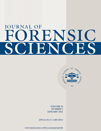Forensic Discrimination of Dyed Hair Color: II. Multivariate Statistical Analysis* ,†
Funded by the Forensic Sciences Foundation Jan S. Bashinski Criminalistics Graduate Thesis Grant, 2008.
Presented at the 61st Annual Meeting of the American Academy of Forensic Sciences, February 16–21, 2009, in Denver, CO.
Abstract
Abstract: This research is intended to assess the ability of UV–visible microspectrophotometry to successfully discriminate the color of dyed hair. Fifty-five red hair dyes were analyzed and evaluated using multivariate statistical techniques including agglomerative hierarchical clustering (AHC), principal component analysis (PCA), and discriminant analysis (DA). The spectra were grouped into three classes, which were visually consistent with different shades of red. A two-dimensional PCA observations plot was constructed, describing 78.6% of the overall variance. The wavelength regions associated with the absorbance of hair and dye were highly correlated. Principal components were selected to represent 95% of the overall variance for analysis with DA. A classification accuracy of 89% was observed for the comprehensive dye set, while external validation using 20 of the dyes resulted in a prediction accuracy of 75%. Significant color loss from successive washing of hair samples was estimated to occur within 3 weeks of dye application.




